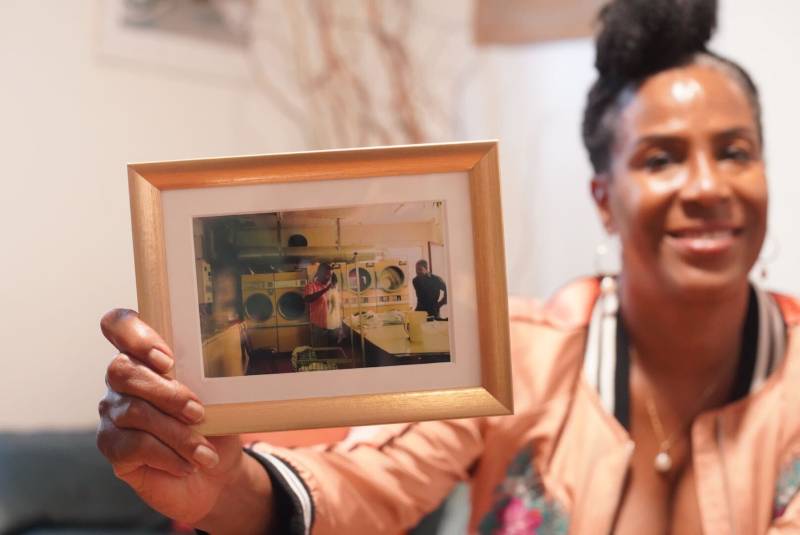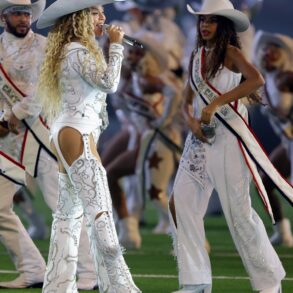View the full episode transcript.
Inside of a classic Queen Anne Victorian in West Oakland, photographer Traci Bartlow displays beautifully framed images of the people who shaped hip-hop culture here in the Bay Area, and across the nation.
Her exhibition, Oakland Picture Lady: Tales of the 90’s Girl, features photos of Outkast and Queen Latifah, Busta Rhymes and ODB, alongside images of the Luniz and Shock-G, as well as E-40 and The Click.
While the photos tell a story about what life was like in growing up in Oakland, it’s her house that tells the complex story of multiple generations of Black folks, land ownership and community appreciation.
Traci is the owner of B-Love’s Guesthouse, which is a photography museum and a boutique hotel. With its picturesque front porch and flourishing garden in the back, the building features seven different rooms that folks can rent.

An Ailey School graduate turned Emmy-winning dancer and choreographer, Traci fell in love with the arts through what she experienced in her neighborhood as a child. Block parties and family functions introduced her to her love of dance.
Born and raised in East Oakland, she also saw firsthand the importance of a neighborhood hub by watching the multiple ways people would use her mother’s washhouse. It wasn’t just a laundromat but a corner store, a place to get your prom dress made or pick up your Avon order.
She acquired her current home from the late Eddie Mae Holmes, a Black woman who once owned multiple properties in West Oakland. And Traci envisioned using the space for the purposes of artistic expression and community gatherings, including showcasing her work. Now B-Love’s Guesthouse stands as a home for hip-hop history and a safe haven for folks to come together.

This episode originally aired on October 14, 2022 .
Episode Transcript
This is a computer-generated transcript. While our team has reviewed it, there may be errors.
Marisol Medina-Cadena, Producer: Hey Rightnowish listeners, it’s Marisol Medina-Cadena. As we continue to honor 50 Years of Hip-Hop, we’re bringing you an episode from our archive featuring dancer and photographer Traci Bartlow.
Traci documented Bay Area dancers, rappers, and dj’s in the 90’s and still hasn’t put the camera down. This summer, the inaugural Bay Area Hip Hop Archives honored Traci Bartlow for her contributions to the region’s Hip Hop scene. And Pendarvis Harshaw is gonna take it from here, enjoy.
[Music]
Pendarvis Harshaw, host: Mic, mic check one, mic check two. Are we here? All right we’re here…Rightnowish.
[Street ambience ]
Pendarvis Harshaw: Do you know what type of tree it is?
Traci Bartlow, guest: It’s called a bottle brush tree.Usually it’s full of these bright red flowers with skinny pistils and the hummingbirds love it.
Pendarvis Harshaw: Why start here on your tour?
Traci Bartlow: It’s in the shade and it’s a moment to get a feel for the house and the neighborhood.
[Music]
Pendarvis Harshaw: Hey y’all, what’s happening? You’re listening to Rightnowish, a podcast about arts and culture in the bay area. I’m your partna Pen…Pendarvis Harshaw. And today, we’re gonna spend some time in West Oakland.
The neighborhood looks hella different than it did when I was coming up, but all is not lost. There’s still places and people that have weathered the market forces to maintain the character of the area. Like this Victorian house I’m standing in front of with today’s guest, Traci Bartlow.
Traci Bartlow: This is a Queen Anne Victorian house and it was built in 1895.
Pendarvis Harshaw: It’s painted white with a mix of soft yellow and sky blue accents. Potted roses and succulents line the stairwell.. and it’s got this half arch that extends from the porch and frames the door, almost like a house you’d see in a storybook.
Traci Bartlow: It seems like they wanted to make it look like a castle! You know, like with the high ceilings, this beautiful arc, all of this really unique molding on the house. Everything is really grand.
Pendarvis Harshaw: Traci’s home is also a boutique hotel called B-Love’s Guesthouse, where you can rent a room for a day or two.
Traci Bartlow: B-Love’s Guesthouse has served as a healing space and a respite in many different ways.
Pendarvis Harshaw: It’s also a photography museum where you could spend an hour or two just soaking up the rich history. This month, Traci is exhibiting photos she shot of the Town, including images that graced the pages of historic magazines like The Source and Rap Pages.
Traci Bartlow: This image here is the Hobo Junction. And I love this image because they’re selling their tapes out of a box on Telegraph Avenue. In front of the record store! That’s how we did in the nineties.
Pendarvis Harshaw: She had a front row seat to the artists who shaped both the Bay Area hip hop scene and the national hip hop scene.
Traci Bartlow: These pictures are fun! Busta Rhymes and ODB. This was on the set of Busta’s music video. “Woo-ha! Got You All In Check.”
Pendarvis Harshaw: Okay yeah..
Traci Bartlow: Yes, so he shot the video in San Francisco, and so I came out to capture photographs and…
Pendarvis Harshaw: What? That’s tight as hell. I didn’t know that..
Traci Bartlow: Yep!
Pendarvis Harshaw: That’s Isha B doing ODB’s hair?!
Traci Bartlow: Yes! [laughs]
Pendarvis Harshaw: Isha B did ODB’s hair?? What?? That’s crazy!
Traci Bartlow: [laughs] Yep, classic history!
Pendarvis Harshaw: Woah, okay.
So, today we’re focused on Traci Bartlow’s dope photo archive and the story behind the place where these photos are housed.
So wipe your kicks at the door, hang up your coat, relax your shoulders, and take a deep breath: we’re posting up at B-Love’s Guesthouse. Right after this…
[Outdoor Ambience]
Pendarvis Harshaw: Just a few blocks from the women of the Black Panther Party mural and west Oakland Bart station is Traci Bartlow’s home and hotel. It’s a residential street with lots of history…
Traci Bartlow: I acquired this house in 2007 and I acquired the house from a team of people that would buy houses, flip them, and then sell them. They bought the house from a woman named Eddie Mae Holmes. And Ms. Holmes was an African-American woman that came to West Oakland when she was 14 years old. And, um, through her family ownership, she acquired this house, the house I now own, this house on the corner. And in 1965, she had that apartment building around the corner built and on the lower level of the apartment building, she had Holmes Barber Shop. So Ms.Holmes is one of those black women in the community that was providing in so many different ways for everyone.
Ms. Holmes was my friend! I used to make ginger tea and go sit in the kitchen in her house and we would watch The View in the mornings.
Pendarvis Harshaw: [Laughs] Okay!
Traci Bartlow: She was my partna! And she was just really amazed by me like, ‘Oh, this is who bought the house?’ And so she was really encouraging to me as a property owner.
Pendarvis Harshaw: About 15 years ago, Traci converted her home into a guesthouse. People can choose from one of seven rooms for an overnight stay. And at the same time, folks can enjoy the framed photos from Traci’s archives.
Traci Bartlow: Okay here is B-Love’s Guesthouse.
Pendarvis Harshaw: Traci leads me to the kitchenette of the downstairs guest house. Above a small dining room table they’re framed black and white images of kids. I see little girls with barrettes in their hair. In another image, the camera is pointed toward a window sill where a boy with a D.A.R.E. t-shirt is joined by family members, as he looks directly into the camera while eating his cup of noodles. In the background of these images are the streets and structures of the houses in East Oakland– they too are featured characters in the composition of these images.
Pendarvis Harshaw: This photo collection. Ah, this all from the neighborhood?
Traci Bartlow: These are from my neighborhood.
Pendarvis Harshaw: The brick cell phone?
Traci Bartlow: Yes!
Pendarvis Harshaw: I mean, the hairdo, of course, in the fashion. But the brick cell phone and the leaning like “Talk to me and Imma talk back.” That’s what she looks like.
Traci Bartlow: [laughs]
Pendarvis Harshaw: This one. This one as well with the cross colors and then this Benz and even the Lack behind it
[Music]
Pendarvis Harshaw: The photos are a time machine, instantly transporting me back to the East Oakland that I knew as a youth. Outfits that my sister used to rock. And facial expressions looking like kids I used to kick it with. Squinting, I look for a familiar face or two.
Traci Bartlow: These are people that I grew up with. You know, we went to middle school and high school together. My mother owned the laundromat on 98th and Birch, and so everyone would come and do their laundry at my mom’s laundromat. And her business wasn’t just where you can do your laundry. It was like a community center [laughs] where my mom had a sewing machine in the corner and she would do alterations and she would make prom dresses and make outfits for people.
Pendarvis Harshaw: She also sold Avon, and um we had a little store in the back where you could buy candy and chips and sandwiches, and I would make homemade cookies and we would have those ghetto Icees, you know, like Kool-Aid in a cup. So people were always coming to the laundromat. They were like, Miss Bartlow, did you? Can you hem the skirt? And is my Avon ready?
Pendarvis Harshaw: Taken by the beauty of her community and the joy of capturing it on film, Traci started a photography business, shooting people’s portraits and printing them for $2.
Traci Bartlow: And if I didn’t see people in the neighborhood, when I would bring them, I would be like, ‘Oh, stop by the wash house and pick up your order of photos.’
Pendarvis Harshaw: Even before she got into photography, Traci was already into the arts. At age 19, Traci was awarded a scholarship to study dance at New York’s Alvin Ailey Dance Center. A dancer since a kid, she was inspired by both the entertainers she saw on TV and the way folks moved in her community– the family gatherings and community kickbacks–so, this was a dream come true.
Traci Bartlow: This is a picture of my mom escorting me to audition for the Alvin Ailey School when I was 19 years old. We’re at the 34th Street Station in New York City.
Pendarvis Harshaw: And she’s beaming.
Traci Bartlow: She’s beaming! Yes! My mom was very supportive of my dance career.
Pendarvis Harshaw: After finishing the two year professional dance training program, she took performing gigs across the globe. One thing led to another and Traci dabbled in modeling before picking up the camera herself.
Traci Bartlow: I would also find myself at modeling shoots and just be like, ‘What kind of light is that? Oh, that’s a diffuser? What does that do?’ So I was interested in the hardware of photography.
[Music]
Traci Bartlow: It was just like this natural progression of me knowing about photography and wanting to learn more and also the way I would study magazine layouts. Then I had this eye for how I wanted to capture a photograph.
Pendarvis Harshaw: Traci made her way back to Oakland and this time she really picked up the film camera. She saw the beauty and life in her neighbors and wanted to document that with the same eye and artfulness that fashion magazine photographers did.
Traci Bartlow: My neighbors were amused with me. Like, ‘You’ve been living in New York City. Oh you want us to pose?’ Like, so I would always have my camera. If it was a holiday, a cook, a cookout, kind of holiday. Memorial Day, 4th of July. I would just come outside and take pictures and hang out. So when they saw me, they’re like, ‘Heyyyy! Picture time! Yeah, here come the photo lady, let’s get ready. She’s going to take our picture!’
Pendarvis Harshaw: Traci’s background in dance soon became the focus of her photography.
Traci Bartlow: I’m self-taught, so I started photographing other dancers. And you’ll see many images from this photo shoot, because this was an assignment I gave myself to practice with high speed film.
Pendarvis Harshaw: We make our way from guest room to guest room, photos hung everywhere.
[Music]
There’s this one black and white image of teenage b-boy dancers in throwback gear: one is rocking a visor, another in a pair of Marvin the martian shorts– just dripping with youthful 90s flavor.
In front of a brick wall, one guy is doing a crazy handstand and the other is seen jumping 3 feet off the ground hitting a pose. In spite of all the movement, everything is captured in crisp detail, no blur.
Traci Bartlow: And the dancers are two of the members of Housing Authority. And Housing Authority was this bad ass crew of all male dancers from Oakland and Richmond, Black and brown men. And they were running things in the nineties.
Pendarvis Harshaw: One of the dancers in the photo is Fly Styles who went on to be a successful backup dancer and choreographer for musicians like Usher and Missy Elliot. Same goes for other Town folks that Traci has photographed in the 90s. Most are now thriving in the entertainment world or powerhouses in the local arts and culture scene.
Traci Bartlow: This is Aisha Bilal, Layla Jenkins, Asha Karima and Ingrid Best. We were at DeFremery Park at an event there. This is 1997. We were having a conversation. And in that moment, I just stepped back from the cipher and leaned down and captured this photograph of them.
Pendarvis Harshaw: Black and white, the posture, arms across, you know, like stoic for the most part and angled up. You’re like looking up at them.
[Music]
Traci Bartlow: My tentative title for this one is “Giant” because of how larger than life these women are, not only in the photograph, but in real life. They have all been just very powerful and dynamic in their lives, in their families, in their communities, in business. It’s really amazing just to see who these women are even today.
Pendarvis Harshaw: Look, she really has a house full of anecdotal stories about artists at every turn.
Traci Bartlow: Here we are…
Pendarvis Harshaw: Entering the next room.
[Music]
Traci Bartlow: So this is one of the rooms that I rent out for B-Love’s Guesthouse, and people are just, like, rejuvenated and just excited to have a good night’s rest in this comfortable plush queen bed surrounded by all this art, these high ceilings, chandelier, and just this big picture window that brings so much morning sunlight into the room.
Pendarvis Harshaw: You’ve got some legends in here. Like, that’s a portrait of Shock G, the late. And this is the Luniz it looks like. That’s fresh out of high school Luniz.
Traci Bartlow: [laughs] That picture was taken backstage as Summer Jam… mhmmm
Pendarvis Harshaw: This is ’97. So this is yeah, post “I Got Five On It.”
Traci Bartlow: Yeah.
Pendarvis Harshaw: They are still riding that wave.
Traci Bartlow: Mm. Mm mm. One of the things I would do as a photographer in starting out and being self-taught is, I would get a great photo of an artist. I would look on the liner notes of their album and find out who the management was, send them the photo with the cover letter and introduce myself. Sometimes I would write with a ballpoint pen on the back of the photo, like “photo by Tracy Barlow. Copyright 1994.”
[Music]
Pendarvis Harshaw: To break into the industry, Traci had to put herself out there. And with all those portraits that she shot of her neighbors, dancer friends, and hip hop artists on the rise– that became her portfolio of work that she carried with her in a Walgreens photo album just waiting for that right moment when she’d have to pull it out.
Traci Bartlow: And so I talked my way into Chi Modu’s office!
Pendarvis Harshaw: The late Chi Modu is thee late ‘90s hip-hop photographer. He famously photographed Biggie, Eazy-E, Mobb Deep, Nas, members of the Wu Tang Clan, and Tupac. His artwork is culture visualized.
Traci Bartlow: And I said, ‘I’m from Oakland, and if I get pictures of the scene in Oakland, then maybe you could publish them in your magazine?’
And he looked at this portfolio with all these faces from deep East Oakland, and he was like, ‘You have a good eye.’ He said, ‘Let’s do it. You capture photos of the scene. Maybe we’ll publish them.’ And the first photo that was published was this image of Hiero at Hip Hop on the Green, and this was published in the Source Magazine.
[Music ]
Pendarvis Harshaw:Hip Hop On the Green was this dope outdoor concert that was held in the East Bay throughout the 90s. And Traci was there to document it! Her photos of the event helped spread awareness of Bay Area Hip Hop Culture to the rest of the country.
Traci Bartlow:From Hip Hop On the Green…look at E-40.
Pendarvis Harshaw: Oh, Mail Man time.
Traci Bartlow:Yes.
Pendarvis Harshaw: Mail Man! Okay, Slurricane.
Traci Bartlow: Yeah, the Mossie. B-legit. Suga-T.
Pendarvis Harshaw:Oooh, look at the finger waves.
Traci Bartlow: Yes and the Cross Colours.
Pendarvis Harshaw: Nice!
It should be noted that while Traci is fully in community with folks, she’s largely doing this on her own: Her photos. Her home. Her idea. And her actualization. She’s not waiting around for someone to give her a platform or to recognize her contributions to the culture, she’s just doing it herself.
And in a place where Black folks have been under-resourced, overpoliced, locked-up and pushed out of the Town for decades, for her to hold space for herself, her work and her community? Cmon, man, we’ve gotta recognize the power in that.
[Music]
Traci Bartlow: I’m amazed that I survived foreclosure. There was many moments of just the spirit of detachment. This may not work out.
Pendarvis Harshaw: Yeah.
Traci Bartlow: I would come home. Those notices were posted on my front door. This house is up for auction on the county courthouse steps at 6 a.m.
Pendarvis Harshaw: After surviving foreclosure, Traci opened up her space, allowing people to rent out rooms. The guests? It started with her network of artist friends…
Traci Bartlow: And I was like, Well, I think I’m going to start renting out rooms to people that I know that are coming to town for residencies, for conferences, for events, for direct actions. Like these are people that I know come to the Bay Area for these different things. I know all the African dance festivals. I know the B Boys, I know the film festivals, I know the National Poetry Slams. Like, that’s my life! Artists and activism is my life.
[Music]
Pendarvis Harshaw: That’s beautiful… to have it come almost naturally, like from your experience is poured into you and also it benefits the larger community.
Traci Bartlow: Yeah, there are people in this neighborhood that have been here for a long time, as well as a mix of new people that are coming in. So to honor this history of the black experience in West Oakland is really important to me.
Pendarvis Harshaw: The house itself is preserving history. And then within the house you have history on the walls. And it’s not all historical, it’s forward moving, like you have people coming through in real time…who are culture makers, people, cultural icons, you know. And so I just wanted to get a sense of some of the people who’ve come through here.
Traci Bartlow: Yes!!! Norma Miller, the queen of swing! The Lindy Hop champion! She’ll be like,’ Nope, I don’t want to be at the Marriott.’ She’s like, ‘I want to be at B-Love’s Guesthouse.’ Because it was like she wanted to be immersed in Black culture.
B-Girl FaTara from New York. She came out for a breaking event here in Oakland. And she said, ‘I’ve stayed at so many AirBnbs, but this is like a Black house, like the incense you have burning, the beans you got cooking, like it smells and feels like the house of an African American person.’ So people are coming here and they may be in this gentrified neighborhood, but they’re like, Oh, but this is I, this is the Black lady’s house! [laughs]
[Music]
Pendarvis Harshaw: ‘Thank you’ doesn’t do justice, man. I want to offer my sincere appreciation to Traci Bartlow. Thank you for your art, your hospitality and for your time. Also, thanks for being a pleasant community member, just a delightful person to see at an event and around the Town. Thank you.
You can find more information at b-lovesguesthouse.com or blovesguesthouse on Instagram.
Traci’s instagram is tracibartlow and we’ll add a link to more information on her photo exhibit to the show notes.
Time to give credit where it’s due:
Marisol Medina-Cadena came with me and Traci on this tour, and then produced this joint. Thank you Marisol.
Suzie Racho and Jen Chien edited this one, Christopher Beal engineered this one. Ryce Stoughtenborough is our engagement intern and Justin Ebramehimi and Ria Garewal are the engagement leads. Ethan Toven Lindsey, Jen Chien and Holly Kernan are the KQED execs.
I’m your host Pendarvis Harshaw!
Thanks! Much love and peace to you. Till’ next time.
Rightnowish is a KQED production

Rightnowish is an arts and culture podcast produced at KQED. Listen to it wherever you get your podcasts or click the play button at the top of this page and subscribe to the show on NPR One, Spotify, Apple Podcasts, TuneIn, Stitcher or wherever you get your podcasts.
This post was originally published on this site be sure to check out more of their content.








